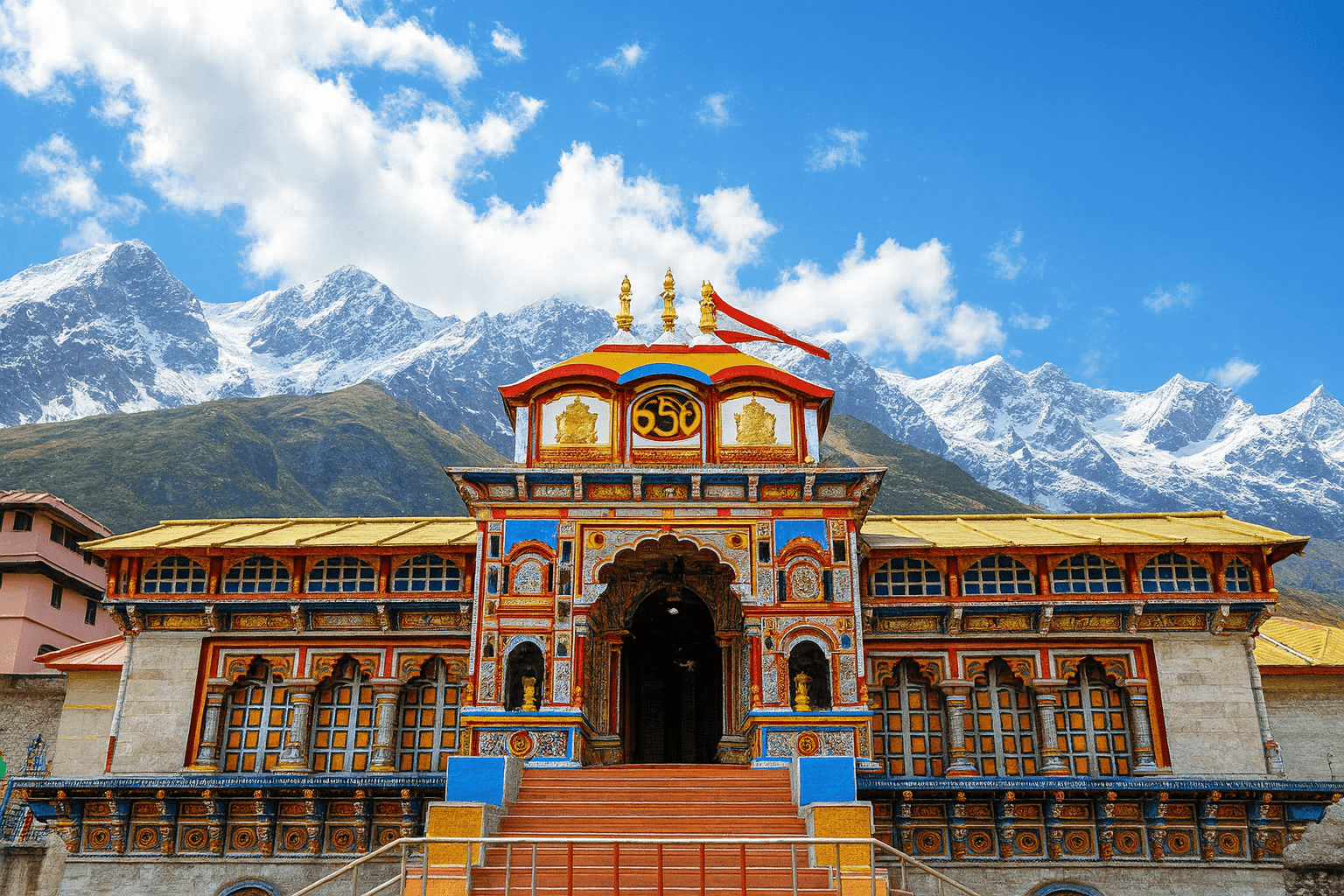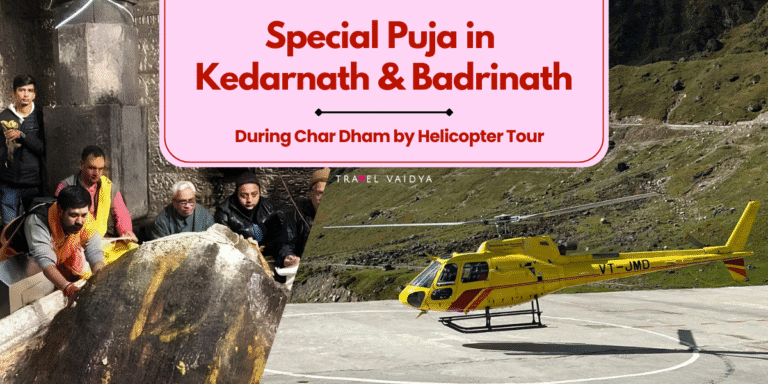Plan your Char Dham Yatra by road with our ultimate travel guide! Discover the best routes, travel times, and road conditions for Yamunotri, Gangotri, Kedarnath, and Badrinath. Plan your pilgrimage seamlessly with this expert-crafted roadmap and make every moment of your journey count!
Table of Contents
Standard Char Dham Route by Road
Haridwar/Rishikesh/Dehradun → Barkot → Yamunotri → Uttarkashi → Gangotri → Guptkashi → Kedarnath → Joshimath → Badrinath → Rudraprayag → Haridwar/Rishikesh
Plan Your Spiritual Yatra With Us !
Get Customised Private Tours by Experts from Travel Vaidya
Char Dham Route Map with Approximate Distances:
Char Dham route map covers Yamunotri, Gangotri, Kedarnath, and Badrinath in Uttarakhand, forming a sacred clockwise circuit. Spanning approx. 1,600 km, the yatra usually takes 10–12 days by road. Ideal for spiritual seekers, the journey begins from Haridwar or Dehradun, with packages starting from ₹28,000. This Char Dham travel map helps pilgrims plan efficiently, ensuring smoother travel through high-altitude Himalayan roads.
- New Delhi to Haridwar – 220 km | 4-5 hours
- Haridwar to Barkot – 180 km | 4-6 hours
- Barkot to Yamunotri Road – 60 km | 2 hours (plus a 6 km trek)
- Barkot to Uttarkashi – 85 km | 3 hours
- Uttarkashi to Gangotri – 100 km | 3-4 hours
- Uttarkashi to Guptkashi – 100 km | 5-6 hours
- Guptkashi to Gaurikund – 200 km | 1-2 hours
- Gaurikund to Kedarnath Trek – 16 km | 7-9 hours (on foot), 3-4 hours (by pony)
- Guptkashi to Badrinath – 200 km | 6-7 hours
- Badrinath to Rudraprayag – 150 km | 4-5 hours
- Rudraprayag to Haridwar – 150 km | 4-5 hours
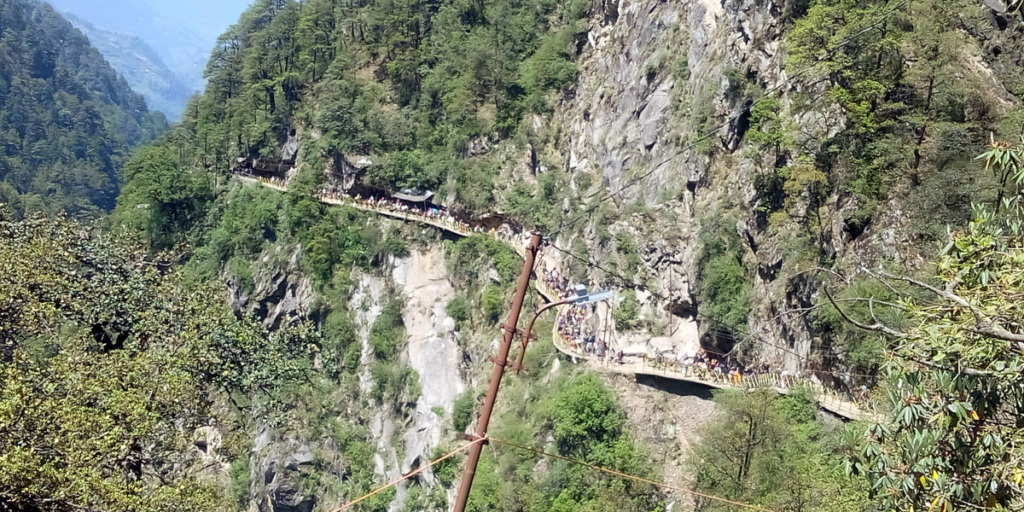
Yamunotri Temple Route Map
The Yamunotri Temple route map outlines the journey from Haridwar or Rishikesh through Dehradun, Mussoorie, and Barkot to Janki Chatti, the last motorable point. From there, a 6 km trek leads to the temple, with options for ponies and palkis. The route offers a mix of scenic beauty and spiritual significance.
Haridwar/Rishikesh → Barkot → Janki Chatti → Yamunotri
Yamunotri Temple Route Map
- Haridwar → Barkot – 210 km (7–8 hrs)
- Rishikesh → Barkot – 190 km (7–8 hrs)
- Barkot → Janki Chatti – 45 km (2 hrs)
- Janki Chatti → Yamunotri Temple – 6 km trek (~2–3 hrs)
How to Reach Yamunotri Temple by Road
- Drive By Road: Haridwar/Rishikesh to Janki Chatti via Dehradun-Mussoorie-Barkot
- By Pony/Palki/Doli: Available from Janki Chatti
- Trek: 6 km uphill trek from Janki Chatti to Yamunotri Temple
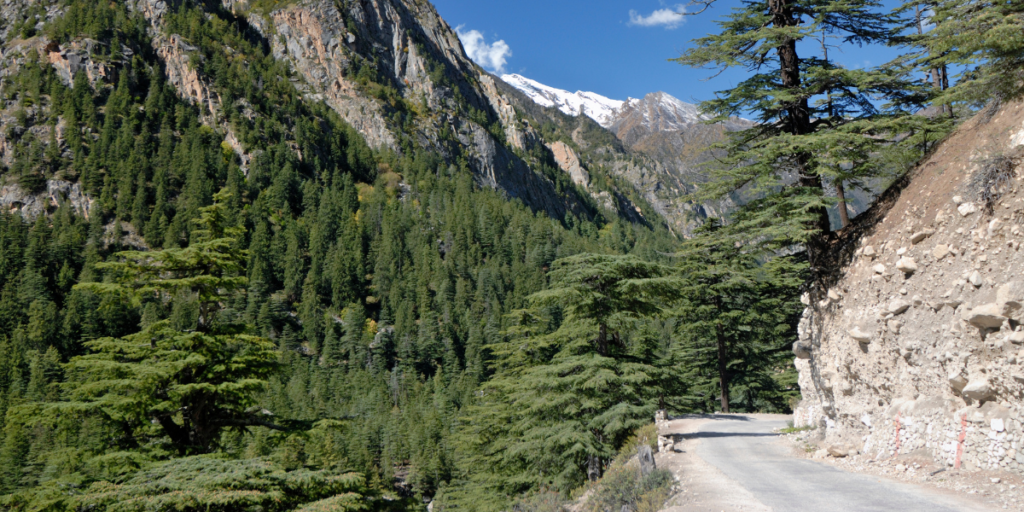
Gangotri Temple Route Map
Route map to Gangotri temple starts from Haridwar or Rishikesh, passing through Dehradun, Mussoorie, Uttarkashi, and Harsil, before reaching Gangotri Temple. The road journey covers about 290 km, offering stunning Himalayan views along the Bhagirathi River. With well-connected roads and resting points, the route is both scenic and spiritually enriching.
Haridwar/Rishikesh → Uttarkashi → Harsil → Gangotri
Route to Gangotri Temple
- Haridwar → Uttarkashi – 190 km (7–8 hrs)
- Rishikesh → Uttarkashi – 170 km (7–8 hrs)
- Uttarkashi → Harsil – 75 km (3 hrs)
- Harsil → Gangotri Temple – 25 km (1 hr)
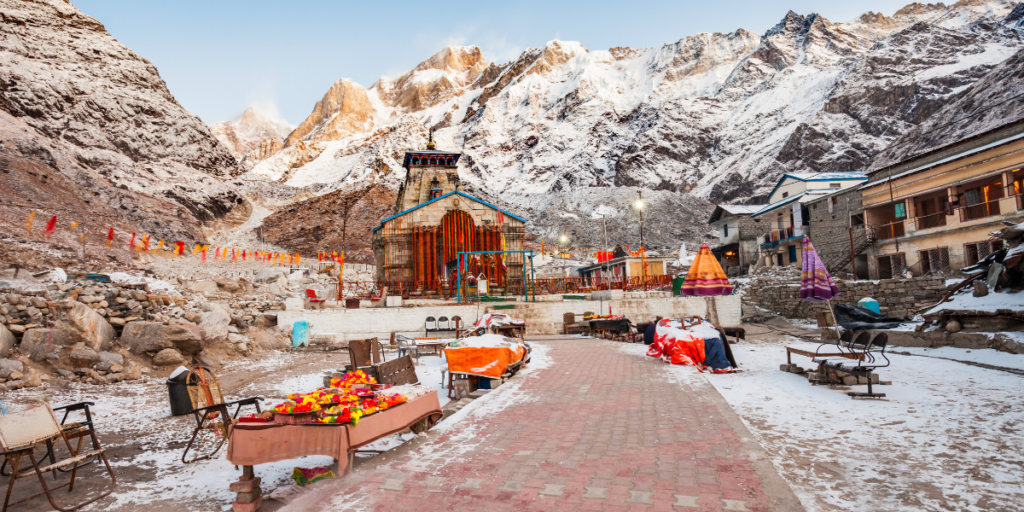
Kedarnath Temple Route Map
The Kedarnath Temple route map details the journey from Haridwar or Rishikesh through Dehradun, Rudraprayag, and Gaurikund, the last motorable point. From Gaurikund, a 16 km trek leads to the temple, with options for ponies and palkis. The route combines spiritual significance with stunning mountain views.
Haridwar/Rishikesh → Gaurikund → Kedarnath Temple
Kedarnath Temple Route Map
- Haridwar → Gaurikund: 210 km (7–9 hrs)
- Rishikesh → Gaurikund: 220 km (7–9 hrs)
- Gaurikund → Kedarnath Temple: 16 km trek (~6–8 hrs)
How to Reach Kedarnath Temple by Road
- Drive by Road: Haridwar/Rishikesh to Gaurikund via Dehradun and Rudraprayag
- By Pony/Palki: Available from Gaurikund
- Trek: 16 km uphill trek from Gaurikund to Kedarnath Temple
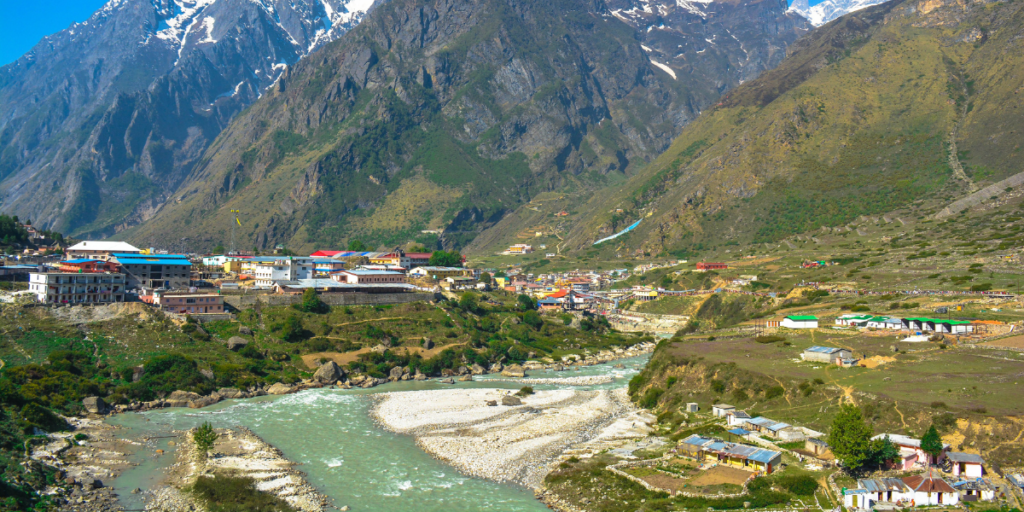
Badrinath Temple Route Map
Badrinath Temple route map guides pilgrims from Haridwar or Rishikesh through Dehradun, Rudraprayag, and Joshimath, the last major stop before the temple. From Joshimath, it’s a short drive to Badrinath. The route is known for its scenic beauty and spiritual significance, leading to one of the Char Dham sites in Uttarakhand.
Haridwar/Rishikesh → Joshimath → Badrinath Temple
Badrinath Temple Route Map
- Haridwar → Joshimath: 275 km (9–10 hrs)
- Rishikesh → Joshimath: 250 km (9–10 hrs)
- Joshimath → Badrinath Temple: 45 km (2 hrs)
How to Reach Badrinath Temple by Road
- Drive by Road: Haridwar/Rishikesh to Joshimath via Dehradun and Rudraprayag
- By Taxi/Bus: Available from Joshimath to Badrinath Temple
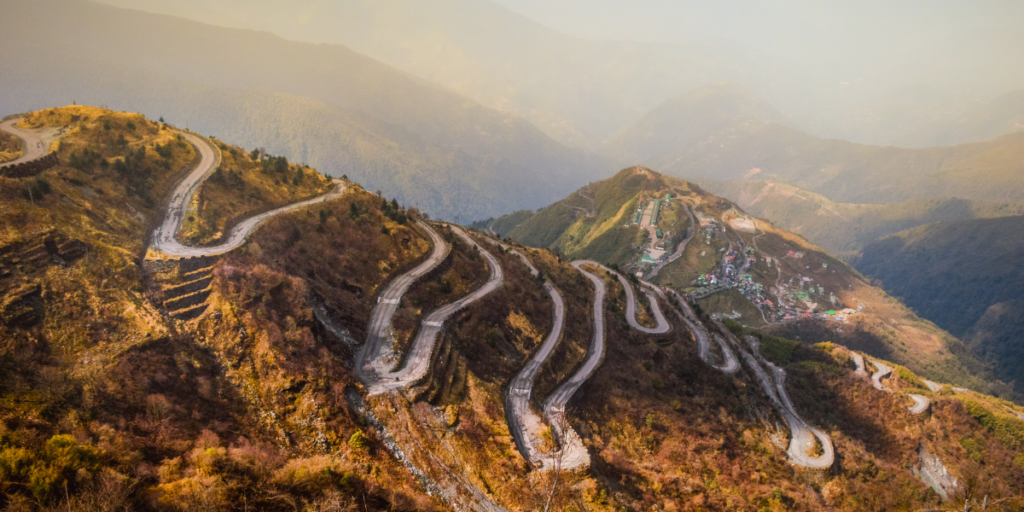
Road Conditions on Char Dham Route
The Char Dham Yatra circuit spans 1,607 kilometers, with ongoing infrastructure upgrades under the Char Dham Pariyojana project. Key areas like Yamunotri, Sonprayag, Chamoli, and Badrinath highway are seeing significant road improvements to enhance accessibility and safety.
- Yamunotri: The final 30–40 km to Yamunotri consists of narrow roads, with ongoing construction to make it an all-weather route.
- Barkot to Uttarkashi: Several sections between Barkot and Uttarkashi having narrow curves, are undergoing repairs and reconstruction.
- Kedarnath Highway: The stretch between Phata and Sonprayag is under construction for road widening.
- Chamoli Village and Joshimath–Badrinath Highway: Critical sections near Chamoli village and along the Joshimath–Badrinath highway are undergoing major reconstruction.
Preparation Tips for Road Travel:
- Stay Informed: Check current road conditions and updates before starting your journey to avoid disruptions. Local authorities and online platforms provide real-time road status.
- Weather Impact: Roads are vulnerable to landslides, especially during the monsoon (June to September). Plan travel during the drier months of April to June or September to October for better road conditions.
- Road Safety: Some roads are narrow and winding, so ensure your vehicle is well-maintained. Drivers should exercise extra caution, especially in high-altitude regions.
- Alternate Routes: In case of road blockages or delays, alternate routes may be available. Always have a backup plan for your journey.
Plan Your Spiritual Yatra With Us !
Get Customised Private Tours by Experts from Travel Vaidya
Char Dham Road Improvement Plan
The Char Dham Road Plan is a government initiative aimed at enhancing road infrastructure for safer and more accessible pilgrimages encompassing the sacred shrines of Yamunotri, Gangotri, Kedarnath, and Badrinath in Uttarakhand, To enhance accessibility and safety for pilgrims.
Key Components of the Road Improvement Plan:
- Widening and Strengthening: Narrow and vulnerable road sections are being widened and strengthened to accommodate increased traffic and improve safety.
- All-Weather Accessibility: Construction is underway to make roads all-weather accessible, particularly the final stretches leading to Yamunotri and other temples, ensuring year-round connectivity.
- Safety Enhancements: Installation of guardrails, improved signage, and construction of safer pedestrian paths are being implemented, especially in steep or hazardous areas, to reduce accident risks.
- Environmental Considerations: The project incorporates measures to protect the fragile Himalayan ecosystem, including slope stabilization, erosion control, and wildlife habitat preservation.
Char Dham Yatra Packages
Char Dham Yatra from Haridwar
Char Dham Yatra from Dehradun
Char Dham Yatra from Rishikesh
Char Dham Yatra from New Delhi
Char Dham Yatra by Helicopter
Kedar-Badri Yatra by Helicopter 4 Days
Kedar-Badri Yatra by Helicopter Same Day

Read Related Blogs
Top Places to Visit During Char Dham Yatra »
Char Dham Yatra Route Map: Best Road Journey Guide »
Char Dham Yatra Significance: Why It’s a Must-Visit »
Top 6 Travel Tips for a Smooth Char Dham Yatra »
Monsoon Packing Guide for Char Dham Yatra »
Summer Packing Checklist for Char Dham Yatra »
What to Pack for Char Dham Yatra: Essentials Guide »
Char Dham Yatra Budget: How Much Does It Cost? »
Planning Char Dham Yatra By Own Car ?
While you can plan to travel Char Dham by your own car, it requires careful preparation and adherence to safety guidelines due to the challenging terrain and high-altitude roads.
- Vehicle Readiness: Ensure your vehicle is well-maintained and capable of handling rough mountain roads. Check the brakes, tires, suspension, and engine to avoid breakdowns. Vehicles should not exceed size limits as narrow, winding roads may restrict movement.
- Experienced Drivers: Only experienced drivers, familiar with mountainous roads and steep inclines, should drive. The Char Dham route features sharp turns, hairpin bends, and unpredictable weather, requiring expertise and caution.
- Daytime Driving: Avoid driving after dark. Mountain roads can be hazardous at night due to reduced visibility and potential wildlife crossings. Always plan to reach your destination before nightfall.
- Safety Precautions: Use safety equipment such as seatbelts and helmets if traveling on two-wheelers. Ensure your car is equipped with emergency kits, including a first-aid box, flashlight, and spare parts for basic repairs.
- Documents and Permits: Carry all necessary documents, including valid ID proofs, vehicle registration, insurance papers, and permits, especially if traveling through restricted areas.
- Load Management: Do not overload your vehicle. Carry only the essentials and ensure proper distribution of weight to maintain balance on narrow, uneven roads.
- Avoid Recklessness: Never drive at high speeds or engage in risky maneuvers. Mountain roads can be slippery, and sudden turns can be dangerous. Prioritize safety over speed.
- Emergency Preparedness: Always have a fully charged phone, emergency contact numbers, and the nearest medical facility or helpline information.
Do’s & Don’ts Guidelines for Char Dham Yatra by Road
Do’s
- Vehicle Size: Your car should not be too big. The wheelbase must be less than 165 inches (4225 mm) and the width less than 98 inches (2500 mm).
- Experienced Drivers: Only skilled and experienced drivers should drive in hilly areas.
- Passenger List: Keep a list of all passengers in the vehicle.
- Right of Way: If you’re going downhill, allow vehicles coming uphill to pass first.
- Safety Kit: Carry a first aid kit and wooden chock for safety.
- Car Maintenance: Before leaving, make sure your car is in good condition—check brakes, engine, tires, and battery.
- Use Genuine Parts: Get car repairs done using genuine parts by skilled workers.
- Valid Documents: Keep your car’s registration, insurance, and your driving license.
- Working Lights: Ensure that your brake lights and stop lights are working.
- Eye Tests: Regular eye tests are a good idea for drivers.
- Green Card: Public transport vehicles must get a special “Green Card” from local authorities.
- Use of Horn: Always use your car horn at curves and bends.
- Handbrake: Apply the handbrake whenever parking your car.
- Emergency Exit: Tourist buses should have an emergency exit door.
Don’ts
- Unauthorized Vehicles: Don’t use unapproved vehicles for the journey.
- Inexperienced Drivers: Do not allow unskilled or unlicensed drivers to drive.
- Driving Hours: Avoid driving before 5 AM or after 7 PM due to weather conditions and darkness.
- Speeding: Don’t drive too fast, especially on steep and winding roads.
- Wrong Footwear: Avoid driving with rubber slippers; wear proper shoes.
- Long Driving Hours: Do not drive for more than eight hours a day.
- Intoxication: Never drive under the influence of alcohol or drugs.
- Distractions: Don’t use your mobile or music while driving.
- Overloading: Do not overload your car with too many passengers or goods.
- Heavy Vehicles: Don’t travel in goods vehicles like trucks or utility vans.
- Worn Tires: Avoid using retreaded tires on hilly roads.
- Dazzling Lights: Do not use high beams or dazzling headlights.
- Overtaking: Do not overtake unless it’s safe, and never overtake a vehicle that’s already overtaking.
- Flammable Goods: Do not carry dangerous items like petrol, gas, or kerosene in your car.
- Char Dham Yatra Taxi Service 2026-Complete Guide
- Hotel Stays During Char Dham Yatra Tour
- Special Puja in Kedarnath And Badrinath During Char Dham by Helicopter Tour
- Hotels Offered In Char Dham By Helicopter Tour
- Char Dham Helicopter Tour Itinerary & Daily Flight Timings
About Travel Vaidya – Trusted Travel Experts of Uttarakhand
Travel Vaidya is a Dehradun-based travel company with deep roots across Uttarakhand. For over 9 years, we’ve helped families, senior citizens, and spiritual travelers explore places like Char Dham, Auli, Jim Corbett, Nainital, Kausani, Almora, and Ranikhet with confidence.
We’re not a call center or big-brand OTA—we’re a small team that builds practical, experience-based itineraries. Every plan is shaped by local knowledge, seasonal awareness, and what actually works on-ground.
From temple visits to hotel check-ins, we handle logistics, route planning, and day-wise support—especially for elders and family travelers. We share what we know from living here, not from reading about it.
This guide is part of our effort to make travel in Uttarakhand easier to understand and plan.

Read Related Blogs
Essential Packing Tips for Senior Citizens on Char Dham Yatra »
Char Dham Yatra by Road: Everything You Need to Know Before You Go »
The Ancient Roots of Char Dham Yatra: A Journey Through History »
Char Dham Yatra in Monsoon: Risks, Precautions & Travel Tips »
Char Dham Yatra in Summer: Best Time to Visit & Travel Tips »
How to Book Char Dham Yatra Online: A Step-by-Step Guide »
Char Dham Yatra Peak Season: Best Time, Crowds & Smart Travel Tips »
Char Dham Yatra Road Conditions: What to Expect & Travel Tips »
Emergency Services on Char Dham Yatra Route: Hospitals, Helplines & Safety Tips »


